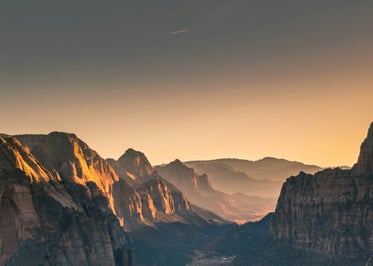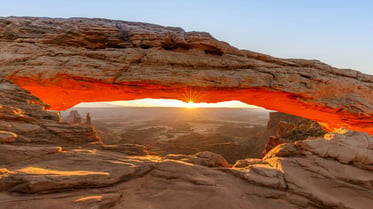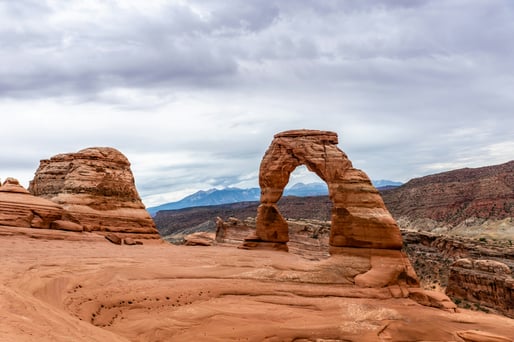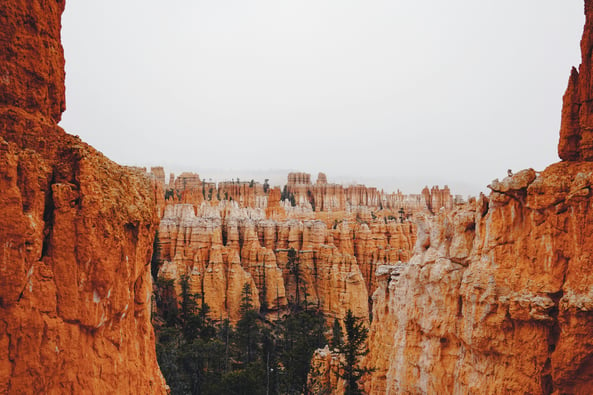Utah National Parks Destination Guide
This essential guide will help you prepare for an unforgettable camping journey through Utah's magnificent National Parks.



Participatory Camping Experience
Operator's note: This is a participatory camping trip. Everyone will take part in setting up/taking down tents and cooking, with instruction and assistance from Guides. Lunch will be picnic-style or bagged. If you're new to camping, this is a perfect opportunity to learn under expert supervision. A professional Guide will always be there to help, so all levels of experience are welcome!
Essential Travel Information for Utah National Parks
Everything you need to know before your Utah National Parks camping adventure
Transportation
- Vehicle Recommended: Public transportation is limited between parks.
- Park Shuttles: Zion and Bryce Canyon have seasonal shuttle services.
- Driving Distance: Plan for 3-5 hours between parks.
- Road Conditions: Most roads are paved, but 4WD is recommended for the backcountry.
Connectivity
- Cell Service: Spotty to non-existent within parks, best near visitor centers.
- WiFi: Available at some visitor centers and nearby towns.
- Downloads: Download maps, guides, and trails offline before your trip.
- Emergency Communication: Consider a satellite communicator for backcountry.
Water & Supplies
- Water Availability: Limited in parks; fill up at visitor centers.
- Recommended Water: 1 gallon per person per day.
- Grocery Stores: Stock up in gateway towns like Moab, Springdale, or Torrey.
- Gas Stations: Fill up before entering parks; services are limited.
Climate & Weather
- Desert Climate: Extreme temperature swings, even in a single day.
- Summer: Very hot (90-105°F/32-40°C), afternoon thunderstorms.
- Spring/Fall: Moderate days (60-80°F/15-27°C), cold nights (30-50°F/0-10°C).
- Winter: Cold (20-50°F/-7-10°C), potential snow, reduced services.
Emergency Information
- Emergency: 📞 911 (service dependent on location)
- Park Rangers: Available at visitor centers during operating hours.
- Nearest Hospitals: Moab, St. George, Cedar City, Page (AZ).
- First Aid: Carry a comprehensive kit, and know basic wilderness first aid.
Camping Packing Checklist for Utah
Use this checklist to ensure you pack everything you need for your Utah National Parks camping adventure
Clothing & Footwear
- Moisture-wicking t-shirts and long-sleeve shirts
- Quick-dry pants/shorts
- Warm layers (fleece, down jacket)
- Waterproof rain jacket and pants
- Sturdy hiking boots or durable sneakers (broken in, waterproof)
- Camp shoes/sandals
- Hiking socks (several pairs)
- Wide-brimmed hat for sun protection
- Warm layers (nights get cold)
- Bandana or buff (multi-use)
- Swimwear
Toiletries & First Aid
- Daily toiletries (deodorant, toothbrush & toothpaste, etc.)
- First aid kit (include blister treatment)
- Sunscreen (SPF 30+ and apply frequently)
- Lip balm with SPF
- Insect repellent
- Basic medications (pain relievers, antihistamines, etc.)
- Personal prescriptions
- Snake bite kit
- Towel
Hiking & Navigation
- Day pack for hikes
- Hydration system or water bottles
- Trekking poles
- Trail maps (physical copies)
- Compass
- GPS device
- Binoculars for wildlife viewing
- Field guides (plants, animals, stars)
- Camera and extra batteries/charger
- Dry bags or ziplock bags for electronics
- Emergency whistle
- Emergency blanket
- Flashlight or headlamp
Desert Camping Tips
- Layer Up: Desert temperatures can fluctuate dramatically between day and night. Bring layers you can add or remove easily.
- Sun Protection: The Utah sun is intense at high elevations. Cover up with UPF clothing, hat, sunglasses, and frequent sunscreen application.
- Water Is Life: Carry more water than you think you'll need. Dehydration happens quickly in the desert.
- Leave No Trace: Pack out all trash and follow wilderness ethics to preserve these fragile ecosystems.
Utah's "Mighty Five" National Parks
Discover the incredible natural wonders and best camping spots in Utah's famous National Parks

Arches National Park
Home to over 2,000 natural stone arches, this park features a landscape of contrasting colors, landforms, and textures unlike any other.
Must-See Trails:
- Delicate Arch Trail – A moderately difficult 3-mile round trip to Utah's most famous arch.
- Devils Garden Loop – A challenging 7.8-mile trek showcasing multiple arches.
- The Windows Loop – An easy 1-mile trail perfect for families and sunset views.
Zion National Park
Utah's first national park features massive canyon walls, emerald pools, and hanging gardens in a majestic landscape carved by the Virgin River.
Must-See Trails:
- Angels Landing – Strenuous 5.4-mile round trip with chain sections and panoramic views.
- The Narrows – Wading through the Virgin River between towering canyon walls.
- Emerald Pools – Family-friendly trail to tiered pools and waterfalls.


Bryce Canyon National Park
Famous for its otherworldly hoodoos (irregular columns of rock), Bryce Canyon offers surreal landscapes and stellar stargazing opportunities.
Best Camping Spots:
- North Campground – Open year-round, close to the Visitor Center and Rim Trail.
- Sunset Campground – Open April through October, nestled in a ponderosa pine forest.
Must-See Trails:
- Queens Garden/Navajo Loop Combination – Moderate 3-mile trail among hoodoos.
- Fairyland Loop – Challenging 8-mile trek with fewer crowds.
- Rim Trail – Easy paved path with spectacular viewpoints along the canyon's edge.
Wildlife Viewing Tips
Utah's National Parks are home to diverse wildlife. Here's what you might see and tips for responsible wildlife viewing:
Mule Deer
Common in all parks, especially active at dawn and dusk.
Desert Bighorn Sheep
Look for them on steep cliff faces in Zion and Capitol Reef.
Kit Fox
Small nocturnal predator sometimes seen at twilight.
Golden Eagles
Soar high above canyons, best spotted with binoculars.
Desert Lizards
Common on sunny rocks and trails throughout the day.
Badgers
Elusive diggers occasionally seen in open areas.
Important Trip Information for Utah
Additional details to help you fully prepare for your Utah National Parks camping adventure
Will I get access to safe drinking water?
You will have access to clean drinking water at all times at the campground.
What amenities does the campground include?
Amenities may include restrooms and showers, but can vary from park to park. Please plan accordingly.
Do you recommend travel insurance?
While not required, we highly recommend all travelers get travel insurance for their trip to protect themselves from the unknown! Check out travel insurance options from our partner, worldnomads.com, or from a provider of your choice.
How much should I pack?
As we will be using shared transfers and spaces throughout our tour, we recommend all travelers pack as lightly as possible. Please review our packing list above.
Will there be charging ports?
Most campgrounds will only have electric outlets available in their bathrooms/shower facilities, or buildings such as a main office or gift shop. Power banks are highly recommended.
What gear do you provide?
All your camping equipment (other than a sleeping bag and pillow) will be included. This includes tents, chairs, sleeping pads, stove, canopy, lanterns, and all cooking equipment (pots, pans, dishes, etc).
What tents will we be using?
Tents will be 4-person camping tents, double occupancy. You'll use camping pads on the ground beneath your sleeping bags.
Will there be WiFi?
Wifi and cell service are usually nonexistent or very limited at the campgrounds. Some campgrounds may offer free wifi, although it may be unreliable.
What facilities are available?
Please note that not all campsites offer shower facilities. If that is the case, your Guide will take the group to a place to shower. Please have cash or spare change on hand, as you may need to purchase shower tokens.
Need help searching for a flight?
We recommend Skyscanner.com to compare different routes and rates. Click here to search!
Responsible Camping & Park Ethics
Tips for minimizing your impact and preserving Utah's incredible landscapes for future generations
Leave No Trace Principles
- Plan Ahead and Prepare: Research regulations, weather, and terrain before your trip.
- Travel on Durable Surfaces: Stay on established trails and camp only in designated areas.
- Dispose of Waste Properly: Pack out ALL trash, including toilet paper and food scraps.
- Leave What You Find: Don't take rocks, plants, artifacts, or disturb cultural sites.
- Minimize Campfire Impact: Use established fire rings or stoves, and follow fire restrictions.
Water Conservation
- Minimize Usage: Water is precious in the desert. Use only what you need.
- Dishwashing: Use minimal biodegradable soap and scatter strained dishwater.
- Personal Hygiene: Carry water 200 feet from water sources for washing.
- Water Collection: Never take water from small potholes that wildlife depend on.
- Water Treatment: Always treat natural water sources before drinking.
⚠️ Important Safety Notes
- Flash Floods: Never enter slot canyons if rain is in the forecast, even miles away.
- Heat Safety: Avoid hiking during the hottest part of the day (10am-4pm) in summer.
- Wildlife: Never approach or feed wildlife. Store food securely.
- Cryptobiotic Soil: This black, crusty soil is alive! Stay on trails to avoid damaging it.
Tipping
Tips for Guides, drivers and restaurants are not included. Tips provide supplemental income, and, while not mandatory, are greatly appreciated. If the local teams have added to the experience, please reward them.
Your Guide will also often be your driver throughout your trip. In this case we recommend tipping the combined amount ($20-30) per person/per day.
| Guides | USD $10-15 per person/per day | |
| Drivers | USD $10-15 per person/per day |
